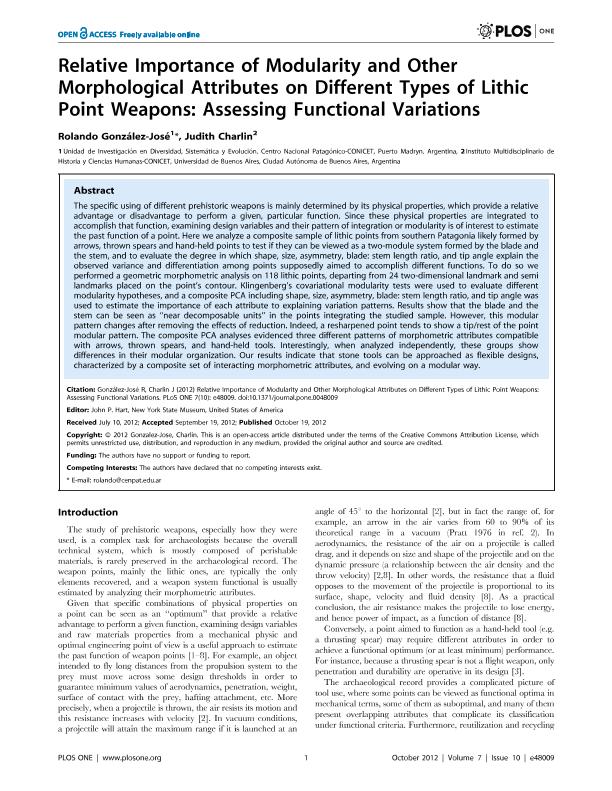Artículo
Relative importance of modularity and other morphological attributes on different types of lithic point weapons: assessing functional variations
Fecha de publicación:
10/2012
Editorial:
Public Library of Science
Revista:
Plos One
ISSN:
1932-6203
Idioma:
Inglés
Tipo de recurso:
Artículo publicado
Clasificación temática:
Resumen
The specific using of different prehistoric weapons is mainly determined by its physical properties, which provide a relative advantage or disadvantage to perform a given, particular function. Since these physical properties are integrated to accomplish that function, examining design variables and their pattern of integration or modularity is of interest to estimate the past function of a point. Here we analyze a composite sample of lithic points from southern Patagonia likely formed by arrows, thrown spears and hand-held points to test if they can be viewed as a two-module system formed by the blade and the stem, and to evaluate the degree in which shape, size, asymmetry, blade: stem length ratio, and tip angle explain the observed variance and differentiation among points supposedly aimed to accomplish different functions. To do so we performed a geometric morphometric analysis on 118 lithic points, departing from 24 two-dimensional landmark and semi landmarks placed on the point´s contour. Klingenberg´s covariational modularity tests were used to evaluate different modularity hypotheses, and a composite PCA including shape, size, asymmetry, blade: stem length ratio, and tip angle was used to estimate the importance of each attribute to explaining variation patterns. Results show that the blade and the stem can be seen as ?near decomposable units? in the points integrating the studied sample. However, this modular pattern changes after removing the effects of reduction. Indeed, a resharpened point tends to show a tip/rest of the point modular pattern. The composite PCA analyses evidenced three different patterns of morphometric attributes compatible with arrows, thrown spears, and hand-held tools. Interestingly, when analyzed independently, these groups show differences in their modular organization. Our results indicate that stone tools can be approached as flexible designs, characterized by a composite set of interacting morphometric attributes, and evolving on a modular way.
Palabras clave:
Archaeology
,
Modularity
,
Integration
,
Lithic Points
Archivos asociados
Licencia
Identificadores
Colecciones
Articulos(IMHICIHU)
Articulos de INST.MULTIDISCIP.DE HISTORIA Y CS.HUMANAS
Articulos de INST.MULTIDISCIP.DE HISTORIA Y CS.HUMANAS
Citación
González José, Rolando; Charlin, Judith Emilce; Relative importance of modularity and other morphological attributes on different types of lithic point weapons: assessing functional variations; Public Library of Science; Plos One; 7; 10; 10-2012; 1-9; e48009
Compartir
Altmétricas




